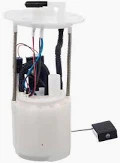To successfully diagnose the issue, optimizing precision is required which further means, while testing a fuel pump with multimeter approach has to be followed step by step. Before testing the fuel pump you need to change your multimeter settings from voltage check mode to ohms and test the resistance of your fuel pump. A healthy fuel pump ought to have a resistance ranging from 0.2 -5 ohms (depending on the model and make). This design for higher flow rates might translate into a pump with lower resistance values, which in turn could make the OHM readings out of spec. The only thing: If the reading falls out of this range then it is quite sure that pump has gone bad and you have to replace this.
Ensuring that the fuel pump is receiving a voltage supply. Fuel pumps work on 12 volts, and if you have an input of say 9V then less power can get to the pump - so there's a problem with maybe a relay or wiring. Countless automotive buffs will agree that it is wise to grip the problem by measuring voltages at both the fuse and in all cases, also directly on up until reaching. It can speed up the parts replacement process, too - fuel pump prices range from $300 to over a grand based on car.
In fact, it is common for mechanics to use a multimeter and check the continuity of the wiring. You can check this by switching the multimeter to continuity and testing in which wiring leading into the fuel pump. Wiring corrosion — A common fault in old vehicles that disrupt the electrical signal and renders fuel pump useless. According to the National Highway Traffic Safety Administration, among the most common causes of fuel pump failure in vehicles over 10 years old are wiring issues.
Occasionally mechanics tell stories of a bad ground connection that caused them to read falsely low voltages. In these sorts of cases cleaning or replacing the ground wire would restore full function. Finally, (obviously) as Mr.Elon Musk says: “First of all, you want to do is put something in place that can generate hope.” Performing a comprehensive test to find the point of fuel pump malfunction can save wasted restorations and expedite repairs.

Testing for the amperage is just as important. A fuel pump will draw a set amount of current, typically 4-10 amps However, if the draw falls out of this range (with a good fuse between), that indicates an issue with your pump or electrical system. If the draw of amperage is on the low side, then we may have to say we are in for a limited time before that fuel pump fails or even worse if it high enough something with those lines are causing an over workload. Industry reports add further weight to these findings; in fact it is theorizes that the pump can be strained by as much a 30% from blocked filters leading the pump to inevitable failure prematurely.
In a case study, the fleet manager for this delivery company found that fuel pump failures became common after only 50,000 miles — half of its expected lifecycle. Resistance testing with a multimeter discovered numerous pumps were drawing way too much amperage because of blocked filters. The problem was fixed and operations were back to normal after the filters had been replaced, preventing repair costs for thousands of dollars.
Fuel pump testing with a multimeter also prevents misdiagnosis, eventually saving money. There are drivers who have been experiencing problems with fuel delivery, but they think the pump is responsible for it - when in fact, a problem can be rooted from the wiring or on any component related. Validating the resistance, voltage and amperage readings give clean data to allow you know what fix decisions are going to be made. Testing the Fuel Pump prevents wasted time and money on replacing good parts, which is more efficient and cost-effective.